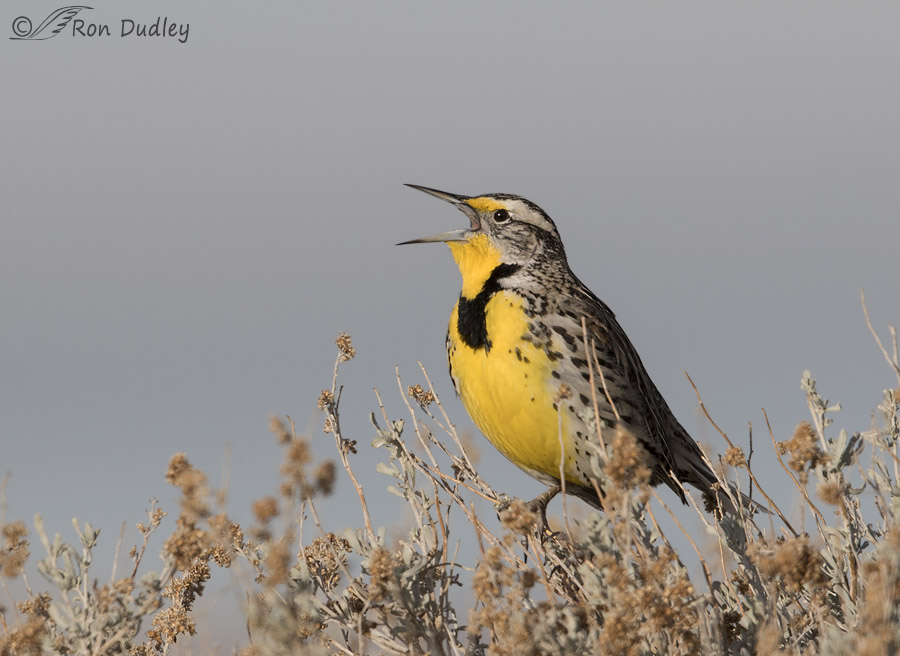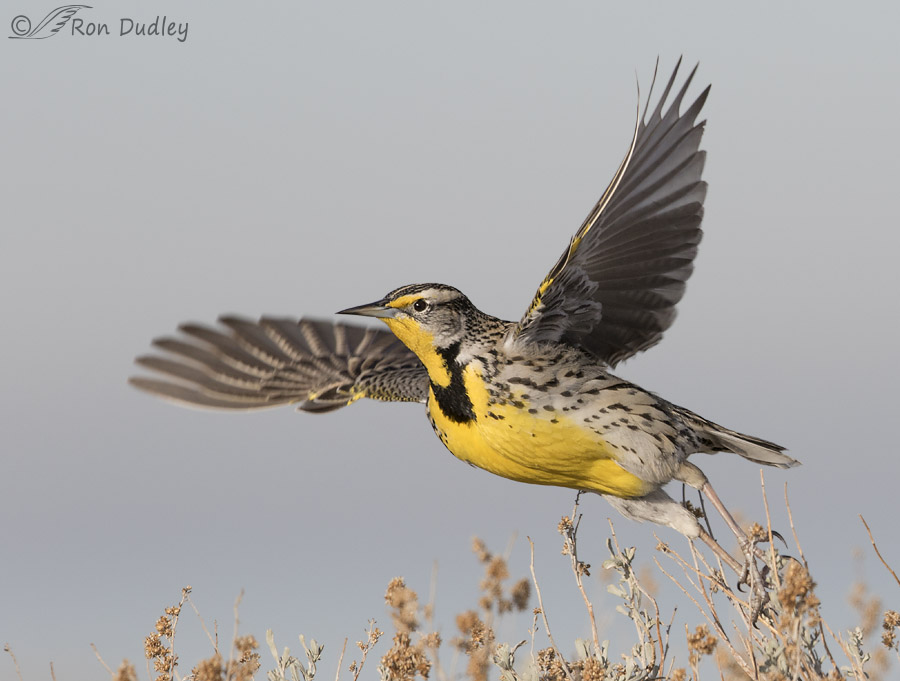Yesterday morning I was able to get a nice take-off shot of a Western Meadowlark on Antelope Island.

1/2500, f/7.1, ISO 640, Canon 7D Mark II, Canon EF500mm f/4L IS II USM, not baited, set up or called in
The bird was singing from a rabbitbrush perch which partially obscured parts of the body and tail so I removed my teleconverter and hoped for something I liked better if/when it took off and this time the meadowlark cooperated.

1/3200, f/7.1, ISO 640, Canon 7D Mark II, Canon EF500mm f/4L IS II USM, not baited, set up or called in
When it launched I was able to get an action pose I like with the head clear of the right wing, good eye contact, a catch light and most of the bird is sharp and in good light. The right wing is soft mostly due to lack of depth of field but that softness looks like motion blur so I have no problem with it.
I often include what to me are less desirable images in my posts (like the first one here) for no other reason than to set the stage for what comes next with the shot(s) I like better but perhaps doing so is superfluous. If you have an opinion on the matter, either way, I’d appreciate knowing it. Perhaps most folks would prefer to see just the primary (best) image(s).
It’s something I’ve often wondered about…
Ron
Note: For those interested many folks (including me) were out looking for the Gyrfalcon on the Antelope Island causeway yesterday but as far as I know now one spotted it. There’s a lot of hunting space for that bird out there so it could still be in the area but it’s also possible that it flew the coop.


Hi Ron,
Please help me out with aperture settings for depth of field. You often shoot at 5.6, but these are at 7.1 and you point out lack of enough depth of field. How far away were you from the bird? Do you choose aperture depending upon how close you are to the bird? How does choice of aperture differ with my 400mm lens?
Deedee
Deedee, I’m not sure how far away from the bird I was but this isn’t a huge crop.
I generally choose aperture with two variables in mind – how far away I am from the bird and what shutter speed I need for the situation. Often there is no perfect setting so it’s a compromise.
You’d have significantly more DOF at 400mm than I do with the 500mm (at the same distance from the subject), especially with the 1.4 teleconverter attached as I had done here.
Here’s a handy-dandy DOF calculator. It’s very good at telling you how much DOF you have at given focal lengths with a particular camera and lens. http://www.dofmaster.com/dofjs.html
What pretty birds they are!
Thank you very much for your input regarding my question, everyone! It seems to be unanimous that my original gut instinct was correct to include “stage setting” images as often as is appropriate so I’ll continue to do so. It’s nice to finally know for sure which route I should generally go!
I love both images, but especially the first as I find ones of that bird singing its heart out most typical. Like plump, healthy look of the bird, too….Some time ago, I made a thistle feeder out of an old, plastic tennis ball cannister that has always been popular with various small birds, especially finches. Lately, we’ve seen a flock of Goldfinches coming to it…seems early to see so many, like they’re already beginning to change into their spring plummages a bit early, too…Still lots of snow on the ground, bitterly cold, so no eary warming to initiate this. Makes me wonder….always worry about food sources, nesting temps, when I see birds around earlier than usual…
I like the pre-shots, too. This is the picture you see in several bird books on identification. It really helps me a lot.
Your photos are beautiful, and like Chris Duffek stated above, I like everything about your post. Also, the fact that it is short and you can read/view it in a minimal amount of time.
I will weigh in on the side of liking the stage-setting images. Maybe it’s because I’m not so great at photography, but I’m not as bothered by the ‘imperfections’ in images like the first one as some might be. I like having context for the great images.
I agree with many post I read. The “set up shot” stages the following shot, and if anything conveys for me the delight of seeing the bird first hand. The first glimpse when the sighting happens, (and I can “hear” that Meadowlark sing by the way) and then the takeoff; how many of us have watched that either through binoculars or with our unaided eyes. Your photos tell a story and take me to the site every time. Thank you!
I like to see it all. I take a lot of photographs and reading your opinion of what makes a shot good or excellent gives me something to think about. Including the process creates authentic posts for viewers. It’s good to know that not every shot you take and like are perfect. Life is interesting and I like seeing that in your posts from both a learning standpoint and a personal one.
I prefer to go from bad to magnificent. So for me there is nothing wrong with the way you set the stage. It creates very good expectations about what is coming next. And so far I have never been deceived.
Thank you.
Hi Ron,
Your images first brought me to this site a couple years ago. What keeps me coming back (almost daily) are the stories, set-ups, biology, ornithology, camera/lens techniques, and reading about some of the same bird photography frustrations/successes I have over here on the east coast. Thx and keep up the great work!
Chris
PS I was in SLC a couple weeks ago and though my intent was to get out to Antelope a couple times, work got in the way and my gear stayed in the hotel…maybe next time.
Beautiful Meadowlark Ron, I really like the “pre-shot” pictures. They sort of set the stage and better show how a sequence like the launch started. Keep-em comin! Jer
Wow! Stunning shots Ron!
Charlotte
Thank you, Charlotte.